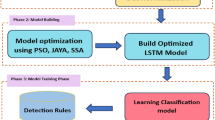Abstract
The evolution of network services is closely connected to the understanding and modeling of their corresponding traffic. The obtained conclusions are related to a wide range of applications, like the design of the transfer lines’ capacity, the scalar taxing of customers, the security violations and the spotting of errors and anomalies. Intrusion Detection Systems (IDS) monitor and analyze the events in traffic, to locate indications for potential intrusion and integrity violation attacks, resulting in the violation of trust and availability of information resources. They act in a complimentary mode with the existing security infrastructure, aiming in the early warning of the administrator, offering him details that will let him reach proper decisions and correction actions. This paper proposes a network-based online system, which uses minimum computational power to analyze only the basic characteristics of network flow, so as to spot the existence and the type of a potential network anomaly. It is a Hybrid Machine Learning Anomaly Detection System (HMLADS), which employs classification performed by Evolving Spiking Neural Networks (eSNN), in order to properly label a Potential Anomaly (PAN) in the net. On the other hand it uses a Multi-Layer Feed Forward (MLFF) ANN to classify the exact type of the intrusion.
Access this chapter
Tax calculation will be finalised at checkout
Purchases are for personal use only
Similar content being viewed by others
References
Dahlia, A., Zainaddin, A., Hanapi, Z.M.: Hybrid of fuzzy clustering neural network over NSL dataset for intrusion detection system. J. Comput. Sci. 9(3), 391–403 (2013)
Delorme, A., Perrinet, L., Thorpe, S.J.: Networks of integrate-and-fire neurons using rank order coding B: spike timing dependant plasticity and emergence of orientation selectivity. Neurocomputing 38–40(1–4), 539–545 (2000)
Denning, E.D.: An Intrusion-Detection model. IEEE Trans. Softw. Eng. 13, 222–232 (1987). doi:10.1109/TSE.1987.232894
Garcıa, P., Verdejo, J., Fernandez, G., Vazquez, E.: Anomaly-based network intrusion detection: techniques, systems & challenges. Comput. Secur. 28, 18–28 (2009). Elsevier
George, H.J.: Estimating continuous distributions in Bayesian classifiers. In: Proceedings of the UAI’ 95, pp. 338–345. Morgan Kaufmann Publishers Inc., San Francisco (1995)
Heaton, J.: Introduction to Neural Networks with Java (2008). ISBN 097732060X
Jakir, H., Rahman, A., Sayeed, S., Samsuddin, K., Rokhani, F.: A modified hybrid fuzzy clustering algorithm for data partitions. Aust. J. Basic Appl. Sci. 5, 674–681 (2011)
Kasabov, N.: Evolving Connectionist Systems: The Knowledge Engineering Approach. Springer, New York (2006)
Günes, K.H., Heywood, A.N.Z., Heywood, M.I.: Selecting Features for Intrusion Detection: A Feature Relevance Analysis on KDD 99 Intrusion Detection Datasets, Natural Sciences and Engineering Research Council of Canada (1999)
Kohavi, R.: A study of cross-validation and bootstrap for accuracy estimation and model selection. In: 14th International Joint Conference on Artificial Intelligence, vol. 2, no. 12, pp. 1137–1143 (1995)
Βharti, K., Shweta, J., Sanyam, S.: Fuzzy K-mean clustering via random forest for intrusion detection system. Int. J. Comput. Sci. Eng. 02(06), 2197–2200 (2010)
Mehdi, B., Mohammad, B.: An overview to software architecture in intrusion detection system. Int. J. Soft Comput. Softw. Eng. (2012). doi:10.7321/jscse.v1.n1.1
Muna, M., Jawhar, T., Mehrotra, M.: Design network intrusion system using hybrid fuzzy neural network. Int. J. Comput. Sci. Secur. 4(3), 285–294 (2009)
Mehdi, M., Zulkernine, M.: A neural network based system for intrusion detection and classification of attacks. In: IEEE International Conference on Advances in Intelligent Systems - Theory and Applications (2004)
Mukhopadhyay, I.: Implementation of Kalman filter in intrusion detection system. In: Proceeding of International Symposium on Communications and IT, Vientiane (2008)
Novikov, D., Yampolskiy, R.V., Reznik, L.: Anomaly detection based intrusion detection. In: Proceedings of the Third International Conference on IT: New Generations, 10–12 April. IEEE (2006)
Puketza, N., Zhang, K., Chung, M., Mukherjee, B., Olsson, R.A.: A methodology for testing intrusion detection system. IEEE Trans. Softw. Eng. 22, 719–729 (1996)
Han, S.-J., Cho, S.-B.: Evolutionary neural networks for anomaly detection based on the behavior of a program. IEEE Trans. Syst. Man Cybern. 36, 559–570 (2005)
Schliebs, S., Defoin-Platel, M., Kasabov, N.: Integrated feature and parameter optimization for an evolving spiking neural network. In: 15th International Conference, ICONIP 2008 (2009)
Stolfo, S.J., Wei, F., Wenke, L., Prodromidis, A., Chan, P.K.: Cost-based modeling and evaluation for data mining with application to fraud and intrusion detection: results from the JAM project. In: DISCEX ‘00 (2000)
Suguna, J., Selvi, A.M.: Ensemble fuzzy clustering for mixed numeric and categorical data. Int. J. Comput. Appli. 2012(42), 19–23 (2012). doi:10.5120/5673-7705
Tartakovskya, A.G., Rozovskii, B.L., Blazek, R.B., Hongjoong, K.: A novel approach to detection of intrusions in computer networks via adaptive sequential and batch-sequential change-point detection methods. IEEE 54(9), 3372–3382 (2006)
Zhou, T.-J.: The research of intrusion detection based on genetic neural network. IEEE Xplore Press, Hong Kong, pp. 276–281 (2008). doi:10.1109/ICWAPR.2008.4635789
Thorpe, S.J., Delorme, A., van Rullen, R.: Spike-based strategies for rapid processing. Neural Networks 14(6–7), 715–725 (2001)
Thorpe, S.J., Gautrais, J.: Rank order coding. In: CNS ’97, pp. 113–118 (1998)
Vapnik, V.: The Nature of Statistical Learning Theory, 2nd edn, p. 188. Springer, New York (1995). ISBN 10:0387945598
Wei, L., Ghorbani, A.A.: Network anomaly detection based on wavelet analysis. EURASIP 2009, 1–16 (2009). (Article No. 4, Hindawi Publishing Corp., New York)
Wysoski, S.G., Benuskova, L., Kasabov, N.: Adaptive learning procedure for a network of spiking neurons and visual pattern recognition. In: Blanc-Talon, J., Philips, W., Popescu, D., Scheunders, P. (eds.) ACIVS 2006. LNCS, vol. 4179, pp. 1133–1142. Springer, Heidelberg (2006)
Author information
Authors and Affiliations
Corresponding author
Editor information
Editors and Affiliations
Rights and permissions
Copyright information
© 2014 Springer International Publishing Switzerland
About this paper
Cite this paper
Demertzis, K., Iliadis, L. (2014). A Hybrid Network Anomaly and Intrusion Detection Approach Based on Evolving Spiking Neural Network Classification. In: Sideridis, A., Kardasiadou, Z., Yialouris, C., Zorkadis, V. (eds) E-Democracy, Security, Privacy and Trust in a Digital World. e-Democracy 2013. Communications in Computer and Information Science, vol 441. Springer, Cham. https://doi.org/10.1007/978-3-319-11710-2_2
Download citation
DOI: https://doi.org/10.1007/978-3-319-11710-2_2
Published:
Publisher Name: Springer, Cham
Print ISBN: 978-3-319-11709-6
Online ISBN: 978-3-319-11710-2
eBook Packages: Computer ScienceComputer Science (R0)




